Sandip Purnapatra
Deep Learning-Based Approaches for Contactless Fingerprints Segmentation and Extraction
Nov 26, 2023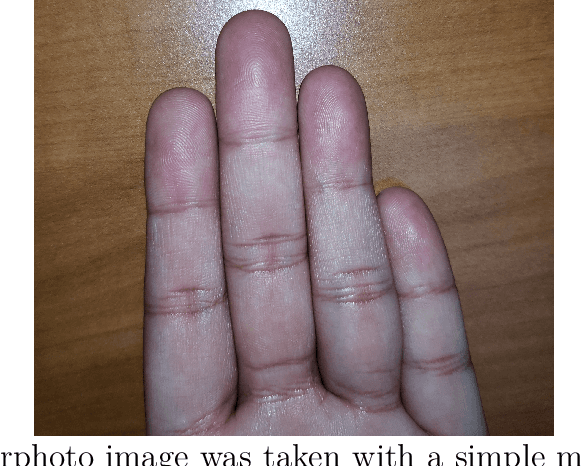

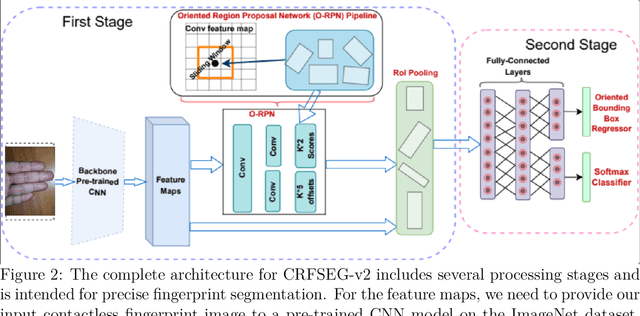
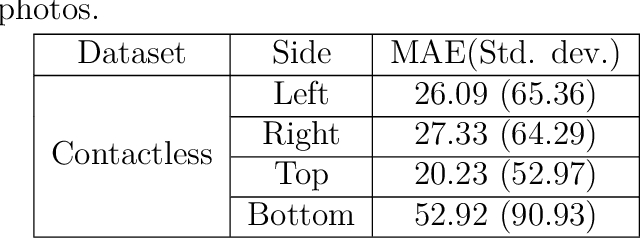
Abstract:Fingerprints are widely recognized as one of the most unique and reliable characteristics of human identity. Most modern fingerprint authentication systems rely on contact-based fingerprints, which require the use of fingerprint scanners or fingerprint sensors for capturing fingerprints during the authentication process. Various types of fingerprint sensors, such as optical, capacitive, and ultrasonic sensors, employ distinct techniques to gather and analyze fingerprint data. This dependency on specific hardware or sensors creates a barrier or challenge for the broader adoption of fingerprint based biometric systems. This limitation hinders the widespread adoption of fingerprint authentication in various applications and scenarios. Border control, healthcare systems, educational institutions, financial transactions, and airport security face challenges when fingerprint sensors are not universally available. To mitigate the dependence on additional hardware, the use of contactless fingerprints has emerged as an alternative. Developing precise fingerprint segmentation methods, accurate fingerprint extraction tools, and reliable fingerprint matchers are crucial for the successful implementation of a robust contactless fingerprint authentication system. This paper focuses on the development of a deep learning-based segmentation tool for contactless fingerprint localization and segmentation. Our system leverages deep learning techniques to achieve high segmentation accuracy and reliable extraction of fingerprints from contactless fingerprint images. In our evaluation, our segmentation method demonstrated an average mean absolute error (MAE) of 30 pixels, an error in angle prediction (EAP) of 5.92 degrees, and a labeling accuracy of 97.46%. These results demonstrate the effectiveness of our novel contactless fingerprint segmentation and extraction tools.
Iris Liveness Detection Competition (LivDet-Iris) -- The 2023 Edition
Oct 06, 2023



Abstract:This paper describes the results of the 2023 edition of the ''LivDet'' series of iris presentation attack detection (PAD) competitions. New elements in this fifth competition include (1) GAN-generated iris images as a category of presentation attack instruments (PAI), and (2) an evaluation of human accuracy at detecting PAI as a reference benchmark. Clarkson University and the University of Notre Dame contributed image datasets for the competition, composed of samples representing seven different PAI categories, as well as baseline PAD algorithms. Fraunhofer IGD, Beijing University of Civil Engineering and Architecture, and Hochschule Darmstadt contributed results for a total of eight PAD algorithms to the competition. Accuracy results are analyzed by different PAI types, and compared to human accuracy. Overall, the Fraunhofer IGD algorithm, using an attention-based pixel-wise binary supervision network, showed the best-weighted accuracy results (average classification error rate of 37.31%), while the Beijing University of Civil Engineering and Architecture's algorithm won when equal weights for each PAI were given (average classification rate of 22.15%). These results suggest that iris PAD is still a challenging problem.
Liveness Detection Competition -- Noncontact-based Fingerprint Algorithms and Systems (LivDet-2023 Noncontact Fingerprint)
Oct 01, 2023


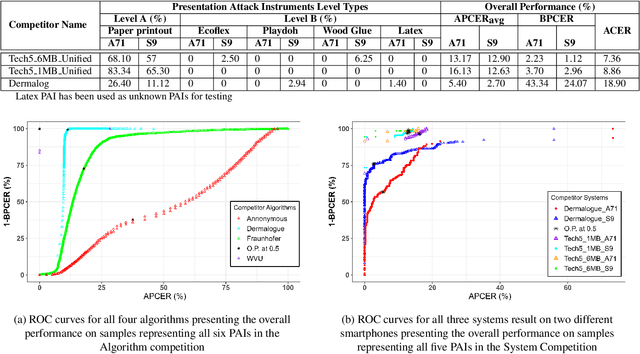
Abstract:Liveness Detection (LivDet) is an international competition series open to academia and industry with the objec-tive to assess and report state-of-the-art in Presentation Attack Detection (PAD). LivDet-2023 Noncontact Fingerprint is the first edition of the noncontact fingerprint-based PAD competition for algorithms and systems. The competition serves as an important benchmark in noncontact-based fingerprint PAD, offering (a) independent assessment of the state-of-the-art in noncontact-based fingerprint PAD for algorithms and systems, and (b) common evaluation protocol, which includes finger photos of a variety of Presentation Attack Instruments (PAIs) and live fingers to the biometric research community (c) provides standard algorithm and system evaluation protocols, along with the comparative analysis of state-of-the-art algorithms from academia and industry with both old and new android smartphones. The winning algorithm achieved an APCER of 11.35% averaged overall PAIs and a BPCER of 0.62%. The winning system achieved an APCER of 13.0.4%, averaged over all PAIs tested over all the smartphones, and a BPCER of 1.68% over all smartphones tested. Four-finger systems that make individual finger-based PAD decisions were also tested. The dataset used for competition will be available 1 to all researchers as per data share protocol
Presentation Attack Detection with Advanced CNN Models for Noncontact-based Fingerprint Systems
Mar 09, 2023



Abstract:Touch-based fingerprint biometrics is one of the most popular biometric modalities with applications in several fields. Problems associated with touch-based techniques such as the presence of latent fingerprints and hygiene issues due to many people touching the same surface motivated the community to look for non-contact-based solutions. For the last few years, contactless fingerprint systems are on the rise and in demand because of the ability to turn any device with a camera into a fingerprint reader. Yet, before we can fully utilize the benefit of noncontact-based methods, the biometric community needs to resolve a few concerns such as the resiliency of the system against presentation attacks. One of the major obstacles is the limited publicly available data sets with inadequate spoof and live data. In this publication, we have developed a Presentation attack detection (PAD) dataset of more than 7500 four-finger images and more than 14,000 manually segmented single-fingertip images, and 10,000 synthetic fingertips (deepfakes). The PAD dataset was collected from six different Presentation Attack Instruments (PAI) of three different difficulty levels according to FIDO protocols, with five different types of PAI materials, and different smartphone cameras with manual focusing. We have utilized DenseNet-121 and NasNetMobile models and our proposed dataset to develop PAD algorithms and achieved PAD accuracy of Attack presentation classification error rate (APCER) 0.14\% and Bonafide presentation classification error rate (BPCER) 0.18\%. We have also reported the test results of the models against unseen spoof types to replicate uncertain real-world testing scenarios.
Iris Liveness Detection Competition (LivDet-Iris) -- The 2020 Edition
Sep 01, 2020
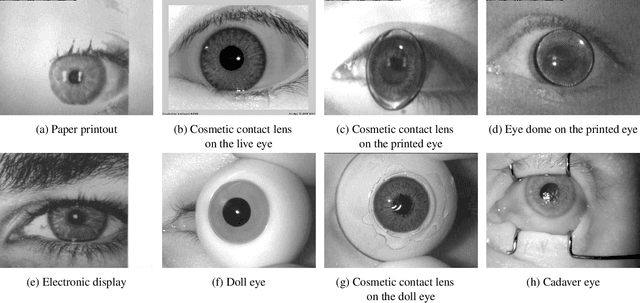


Abstract:Launched in 2013, LivDet-Iris is an international competition series open to academia and industry with the aim to assess and report advances in iris Presentation Attack Detection (PAD). This paper presents results from the fourth competition of the series: LivDet-Iris 2020. This year's competition introduced several novel elements: (a) incorporated new types of attacks (samples displayed on a screen, cadaver eyes and prosthetic eyes), (b) initiated LivDet-Iris as an on-going effort, with a testing protocol available now to everyone via the Biometrics Evaluation and Testing (BEAT)(https://www.idiap.ch/software/beat/) open-source platform to facilitate reproducibility and benchmarking of new algorithms continuously, and (c) performance comparison of the submitted entries with three baseline methods (offered by the University of Notre Dame and Michigan State University), and three open-source iris PAD methods available in the public domain. The best performing entry to the competition reported a weighted average APCER of 59.10\% and a BPCER of 0.46\% over all five attack types. This paper serves as the latest evaluation of iris PAD on a large spectrum of presentation attack instruments.
 Add to Chrome
Add to Chrome Add to Firefox
Add to Firefox Add to Edge
Add to Edge